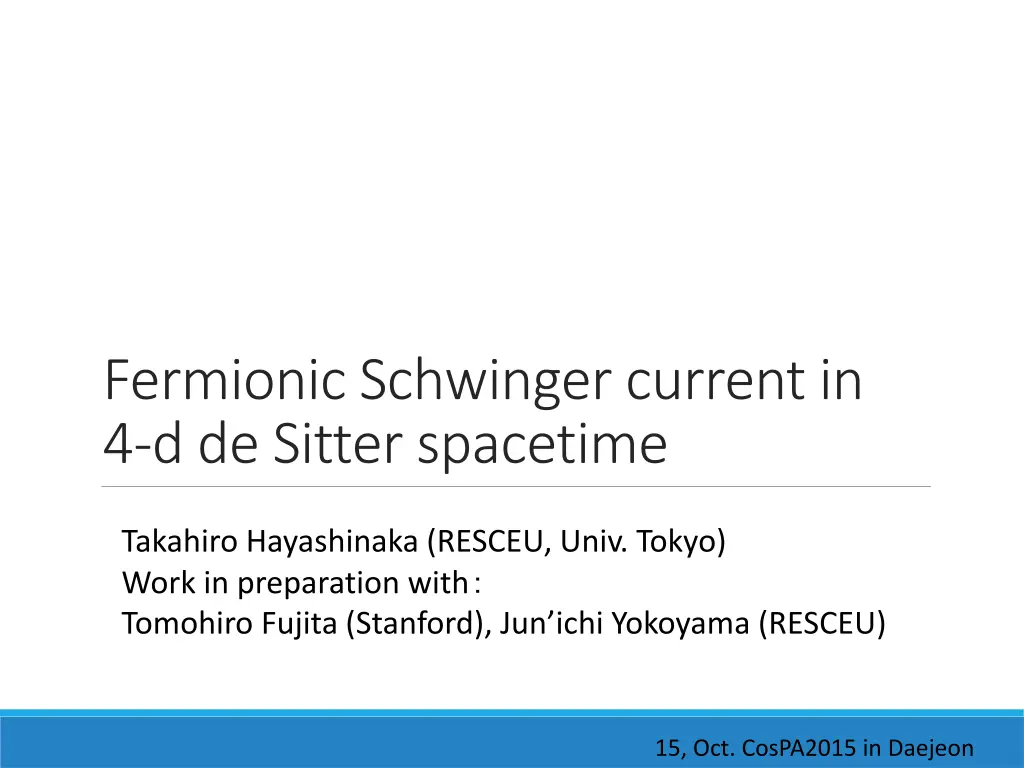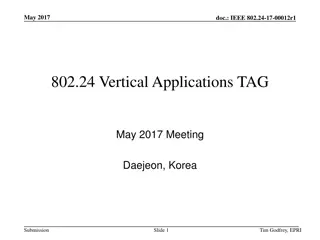
Exploring Fermionic Schwinger Current in 4-D de Sitter Spacetime
Dive into the fascinating research on fermionic Schwinger current in 4-D de Sitter spacetime conducted by Takahiro Hayashinaka and collaborators, examining topics such as magnetogenesis models, large-scale magnetic fields, and the inflationary generation of seed magnetic fields. Discover the intriguing insights into cosmological magnetic fields and the breaking of conformal invariance in electromagnetism, shedding light on the mysteries of our universe.
Download Presentation

Please find below an Image/Link to download the presentation.
The content on the website is provided AS IS for your information and personal use only. It may not be sold, licensed, or shared on other websites without obtaining consent from the author. If you encounter any issues during the download, it is possible that the publisher has removed the file from their server.
You are allowed to download the files provided on this website for personal or commercial use, subject to the condition that they are used lawfully. All files are the property of their respective owners.
The content on the website is provided AS IS for your information and personal use only. It may not be sold, licensed, or shared on other websites without obtaining consent from the author.
E N D
Presentation Transcript
Fermionic Schwinger current in 4-d de Sitter spacetime Takahiro Hayashinaka (RESCEU, Univ. Tokyo) Work in preparation with Tomohiro Fujita (Stanford), Jun ichi Yokoyama (RESCEU) 15, Oct. CosPA2015 in Daejeon
Outline Background Large scale magnetic field and magnetogenesis Models for magnetogenesis Schwinger effect in de Sitter space E.o.m. in gravitational/electric background field Renormalized VEV of current operator Summary
Magnetic field in our universe There are magnetic fields in every scales (stellar - extragalactic). Extragalactic (or cosmological) magnetic fields were found (A. Neronov, I. Vovk, Science, 328, 73 (2010)). The strength of this cosmological magnetic fields is very low, but they got lower limit ?? 10 20 ~ 18 for ? 1Mpc 1. The origin is still unknown.
Magnetogenesis Inflationary generation of the seed magnetic fields. Produced from quantum fluctuation in the early universe In the FLRW universe, B scales as ?? ? 2. Quantum fluctuation of EM fields Modified Electromagnetism produce large fluctuation classicalize Become large scale magnetic field today Stretched out by expansion
Why modified EM? Usual EM action has the conformal invariance Work in de Sitter spacetime (???= ?2???) Nothing happens! We have to break the conformal invariance by hand
Model for magnetogenesis Conformal invariance No electromagnetic field generation occurs Conformal invariance breaking model fFF(IFF) model Coupling between a scalar (not necessary inflaton) and EM kinetic term = Model with time-dependent effective coupling We assume the scalar field depends only on the conformal time
Canonical variables Effective coupling constant Effective coupling fFF model has a time-dependent effective coupling When ? > 0, ?/? is large in the early time. =strong coupling When ? < 0, ?/? is small in the early time. =weak coupling
Spectrum of the EM fields produced by the fFF model Spectrum index E to B ratio For large scale, n( ) J. Martin, J. Yokoyama, JCAP 01 025 (2008)
Problem of the fFF model Strong coupling region calculation is not reliable. Weak coupling region produce electric field too much, not magnetic field Called backreaction problem because it breaks the inflation. V. Demozzi, V. Mukhanov, H. Rubinstein, JCAP 08, 025 (2009) However, Schwinger effect (charged particle production) may be effective when the strong electric field exists.
Schwinger Effect One of the non-perturbative QED effect Strong backgraound fields can produce particles from vacuum. Schwinger s original discussion (1951) Determine the effective lagrangian (EH Lagrangian) from QED action. Imaginary part of the effective action occurs. Effective action
Physics of particle production (in Minkowski) ??? ?? ? ? Compton wave length ? = Electric field Energy Particle energy 1 ? ? ?+ E Typical strength scale of particle production is given by ??Sch ?2
Induced Current The produced particles run along the electric background field, then the electrical current is induced. We consider following analytic case Dirac eq. Background field Induced current
Adiabatic subtraction Solution of the Dirac eq. is used to evaluate the VEV of the induced current and this is indeed (UV-) divergent. To renormalize it, we subtract the adiabatic expansion (also known as WKB exoansion) of the quantity.
WKB solution for Fermion e.o.m. for the mode function (KG type equation for the Dirac) is given by Usual ansatz for WKB expansion does not work. The correct ansatz of the WKB expansion is given by and this gives the correct behavior in large momentum limit.
Induced Current 1 VEV of the current induced by charged scalar in 2 dimensional dS spacetime M. Fr b et al. JCAP 1404 (2014) 009 M. Fr b et al. (2014)
Induced Current 2 VEV of the current induced by charged scalar in 4 dimensional dS spacetime Kobayashi, Afshordi, JHEP 1410 (2014) 166 Negative current!
Induced Current 3 VEV of the current induced by Dirac fermion in 2 dimensional dS spacetime C. Stahl et al. arXiv:1507.01686 No IR hyperconductivity Solid line : Fermion Dotted line : Boson C. Stahl et al. (2015)
Induced Current 4 - preliminary VEV of the current induced by Dirac femrmion in 4 dimensional dS spacetime now proceeding We find the negative current also happens in this case. m/H=1
Summary Inflationary magnetogenesis does not go well so far. The over production of the electric field is the main cause. Schwinger effect may remove the cause. Property of Schwinger effect in dS spacetime is quite different from that in Minkowski spacetime. Even the negative current appears in 4-dimensional case regardless of the spin of the charged particle .


